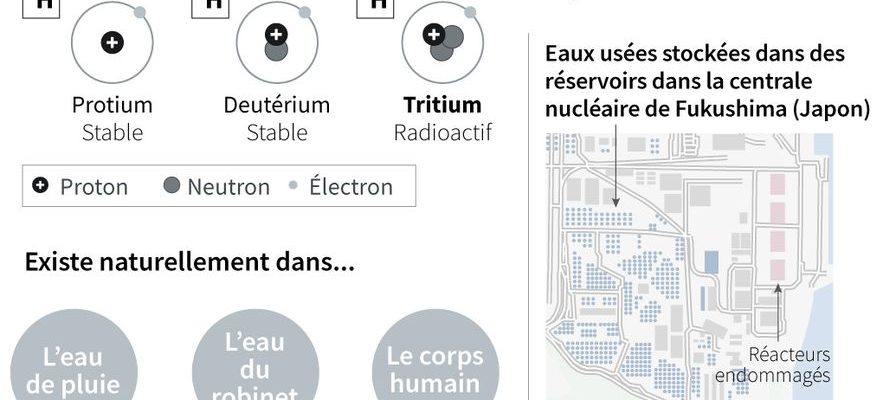Twelve years after the Fukushima disaster, the operators of the nuclear site devastated by a tsunami began, this Thursday, August 24, to discharge into the Pacific Ocean part of the water contaminated with radioactive elements stored on site. The operation should ultimately allow more than 1.3 million m3 of water to be evacuated from the Fukushima Daiichi power plant from rainwater, groundwater and the injections necessary to cool the cores of the melting reactors. after the March 2011 disaster.
The subject is sensitive and did not fail to make Japan’s neighbors and local fishermen react. Because although filtered by a process which makes it possible to eliminate most of its radioactive substances, it does not make it possible to eliminate tritium, a radionuclide which can present a health risk when it is inhaled or ingested in high doses. The site operator, Tepco, therefore plans to dilute this “tritiated” water to reduce its level of radioactivity to less than 1,500 becquerels per liter (Bq/L), well below the national standards of 60,000 Bq/L for this category.
Japan plans to discharge sewage from the Fukushima plant containing tritium into the ocean, which the IAEA considers “harmless to the environment and human health”
© / AFP
La Hague first emitter of tritium
Despite the geopolitical indignation, and the concern of the fishermen, this event would therefore present nothing alarming. The International Atomic Energy Agency also spoke out in a report released on July 4 on the dangerousness of these discharges. According to its conclusions “the approach and activities for this landfill comply with relevant international safety standards and would have negligible radiological impact on people and the environment”.
In fact, nuclear facilities all release more or less significant quantities of tritium. France is even one of the main contributors on an international scale. “The largest releases of tritium in the world take place in France, within the Orano radioactive waste reprocessing plant in La Hague”, warns David Boiley, the president of the Association for the control of radioactivity in West (ACRO). This installation, which makes it possible to recycle part of the spent fuel from French power plants, is the main source of tritium of human origin in the world. In 2019, it had participated in more than 80% of the total releases of tritium from global nuclear installations.
As such, the releases planned at Fukushima — which should amount to 22 tera becquerels per year (TBq/year) — could seem minimal in relation to French production. The regulations do not provide for an overall discharge limit for all facilities, but maximum discharge levels (gaseous and liquid) are set annually according to the volumes produced by the sites. Thus the Chinon nuclear power plant has a maximum limit for liquid discharge of tritium set in 2022 at 80 tera becquerels per year. As for the La Hague reprocessing plant, which produces much larger volumes of contaminated water, its threshold is set at 18,000 TBq/yeari.e. 225 times more than the Chinon plant.
Economic impacts
Despite these relatively very high levels of tritium releases observed in France, the authorities ensure that this does not impact the health of populations or the environment. But some scientists believe that these risks are underestimated, and point to the lack of data concerning the carcinogenic effects of tritium.
“In France, dosimetric impact calculations indicate that tritium releases emitted by nuclear power plants only contribute marginally to public exposure,” says the Institute for Radiation Protection and Nuclear Safety. (IRSN) in a note on the biological effects of this particle. Clearly, the discharges from the power plants add very little radioactivity to that produced naturally. However, maximum levels of tritium presence are expected for drinking water. In France, the Public Health Code sets a quality reference for drinking water at 100 Bq/l, which is one hundred times less than the WHO health threshold, established at 10,000 Bq/l. Especially since according to the IRSN, this reference “does not represent a health limit but a threshold which, when exceeded, leads to additional investigation to characterize the radioactivity of the water”.
Diluted upstream of the discharges, then in the Pacific Ocean, the quantities of tritium from Fukushima should not have a significant effect on the environment or populations, but they could have economic repercussions. Japanese fishermen fear that this will damage the image of their products, both in the domestic market and abroad. A risk that this time seems very real.
